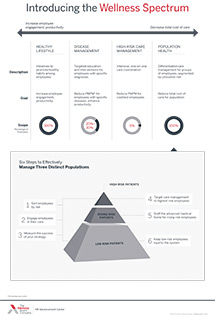Auto logout in seconds.
Continue LogoutJust under 50% of all Americans ages 20 and over say they've attempted to lose weight in the past year, according to data collected between 2013 and 2016 by CDC's National Center for Health Statistics, Karen Kaplan reports for the Los Angeles Times.
Help your employees promote healthy habits—regardless of the newest diet fads
Report findings
The report, based on the National Health and Nutrition Examination Survey, found that women were more likely to seek to lose weight than men, with 56.4% of women and 41.7% of men attempting to lose weight. Middle-aged adults were also more likely to attempt weight loss, with 52.4% of adults in their 40s and 50s attempting to lose weight compared with 49.7% of younger adults and 42.7% of older adults.
According to the report, current weight also played an important role in weight-loss attempts: 66.7% of obese adults (defined as having a BMI of at least 30) attempted to lose weight in the previous year, as did 49% of overweight adults (defined as having a BMI between 25 and 30). The report found that 26.5% of adults at normal weight or who were underweight (defined as having a BMI under 25) reported attempting to lose weight.
Income also played a role. The researchers divided the participants into three income categories:
- Low income, defined as having a family income at or below 130% of the federal poverty line (FPL);
- Middle income, defined as having a family income between 131% and 350% of the FPL; and
- High income, defined as having a family income above 350% of the FPL.
The researchers found that wealthier participants were more likely to try to lose weight, with 53.7% of people in the high-income group reporting having attempted weight loss. By comparison, only 48.7% of people in the middle-income group and 42.9% in the low-income group reported trying to lose weight.
Race played less of a role in whether a person tried to lose weight, with just under 50% of white adults, black adults, and Latino adults attempting weight loss. According to the report, 41.4% of Asian Americans had attempted to lose weight in the previous year.
As for what methods people used to try to lose weight, the report found exercising and eating less were the most popular: Both were attempted by 62.9% of those who reported attempting weight loss. Further, 50.4% said they "ate more fruits, vegetables, or salads"; 44.7% said they "drank a lot of water"' and 35.3% said they "switched to foods with lower calories."
Meanwhile, 42.4% said they cut down on "junk food or fast food," and 38.6% said they cut down on "sugar, candy, or sweets."
So which weight loss diets actually work, according to experts?
While the CDC researchers didn't report which weight loss methods were most successful, U.S. News & World Report releases an annual report on "Best Diets," which asks a panel of "nationally recognized experts in diet, nutrition, obesity, food psychology, diabetes, and heart disease" to rate various diets on a 1 to 5 scale.
In January, the U.S. News panel determined the best overall diet for weight loss is Weight Watchers, although several diets received similar expert scores for weight loss:
(Kaplan, Los Angeles Times, 7/12; Best Weight-Loss Diets, U.S. News & World Report, 1/3; U.S. News & World Report methodology, 1/3).
Help your employees promote healthy habits—regardless of the newest diet fads
Programs aimed at promoting healthy habits among employees are likely to lead to improved employee engagement and productivity—but they're unlikely to reduce the total cost of care. To do that, you'll need to take a population health approach.
Don't miss out on the latest Advisory Board insights
Create your free account to access 1 resource, including the latest research and webinars.
Want access without creating an account?
You have 1 free members-only resource remaining this month.
1 free members-only resources remaining
1 free members-only resources remaining
You've reached your limit of free insights
Become a member to access all of Advisory Board's resources, events, and experts
Never miss out on the latest innovative health care content tailored to you.
Benefits include:
You've reached your limit of free insights
Become a member to access all of Advisory Board's resources, events, and experts
Never miss out on the latest innovative health care content tailored to you.
Benefits include:
This content is available through your Curated Research partnership with Advisory Board. Click on ‘view this resource’ to read the full piece
Email ask@advisory.com to learn more
Click on ‘Become a Member’ to learn about the benefits of a Full-Access partnership with Advisory Board
Never miss out on the latest innovative health care content tailored to you.
Benefits Include:
This is for members only. Learn more.
Click on ‘Become a Member’ to learn about the benefits of a Full-Access partnership with Advisory Board
Never miss out on the latest innovative health care content tailored to you.

